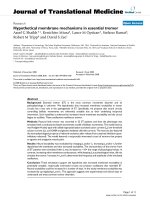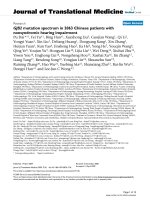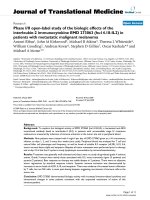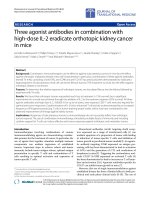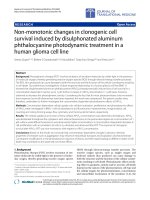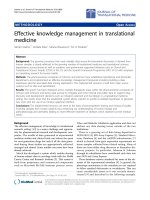báo cáo hóa học: " Violence toward physicians in emergency departments of Morocco: prevalence, predictive factors, and psychological impact" pot
Bạn đang xem bản rút gọn của tài liệu. Xem và tải ngay bản đầy đủ của tài liệu tại đây (291.88 KB, 7 trang )
SHOR T REPOR T Open Access
Violence toward physicians in emergency
departments of Morocco: prevalence, predictive
factors, and psychological impact
Jihane Belayachi
1
, Kamal Berrechid
1
, Fatiha Amlaiky
1
, Aicha Zekraoui
1
, Redouane Abouqal
1,2*
Abstract
Introduction: Anyone working in the hospital may become a victim of violence. The effects of violence can range
in intensity and include the following: minor physical injuries, serious physical injuries, temporary or permanent
physical disability, psychological trauma, and death. The aim of this study was to determine the frequency of
exposure, characteristics, and psychological impact of violence toward hospital-based emergency physicians in
Morocco.
Methods: This was a survey including emergency physicians who ensured emergency service during the last
fortnight. The variables studied were those related to the victim (age and gender), and those related to aggression:
assaulter gender, number, time, reason (delay of consultation and/or care, acute drunkenness, neuropsychiatric
disease), and type (verbal abuse, verbal threat and/or physical assault). After the questionnaire was completed,
State-Trait Anxiety Inventory (STAI) of Spielberg was applie d to all participants.
Results: A total of 60 physicians have achieved permanence in emergency department during the 15 days
preceding the questionnaire response. The mean age was 24 ± 1 year and 57% were male. A total of 42 (70%) had
been exposed to violence. The violence occurred at night n = 16 (27%), afternoon n = 13 (22%), evening n = 7
(12%) and morning n = 6 (10%). Reasons for violence were: the delay of consultation or care in n = 31 (52%) cases,
acute drunkenness in n = 10 (17%) cases and neuropsychiatric disease in n = 3 (5%) cases. Twenty eight (47%)
participants stated that they experienced verbal abuse, n = 18 (30%) verbal threat and n = 5 (8.3%) physical assault.
Exposure to some form of violence was related to a higher median [interquartile range, IQR] state anxiety point
(SAP); (51 [46-59] vs 39 [34-46]; P < 0,001), and trait anxiety point (TAP) (48 [41-55] vs 40,5 [38-53]; P = 0,01).
Conclusions: This study revealed a high prevalence (70%) of violence toward doctors in Morocco emergency
departments. The expo sure of physicians to some form of violence is greater among doctors with anxiety trait and
was related to significant degree of anxiety state.
Introduction
The terms “ work place aggression” and “workplace vio-
lence” are often used interchangeabl y, they are distin-
guishable. Schat & Kelloway suggested that workplace
violence is a distinct form of workplace aggression.
It comprises behaviours that are intended to cause physi-
cal harm (physical assaults and/or the threat of assault)
[1]. All violent behaviours are aggressive whereas not all
aggressive behaviours are violent [2]. Workplace violence
was similar to workplace aggression, but the behaviour
usually is more physical in nature. Schat & Kelloway
offered a general definition of workplace aggression as
“behaviour by an i ndividual or individuals within or
outside an organization that is intended to physically or
psychologically harm a worker or workers and occurs in
a work-related context.” [1]. They suggested that this
definition (a) was consistent with definitions used in the
general human aggression literature [3,4], (b)wassuffi-
ciently general to include a wide range of physical and
nonphysica l b ehaviours that comprise workplace a ggres-
sion, and (c) encompassed aggressive behaviours enacted
by a variety of sources within (supervisors, co-workers)
* Correspondence:
1
Medical Emergency Department, Ibn Sina University Hospital, 10000, Rabat,
Morocco
Full list of author information is available at the end of the article
Belayachi et al. Journal of Occupational Medicine and Toxicology 2010, 5:27
/>© 2010 Belayachi et al; licensee BioMed Central Ltd. This is an Open Access article distributed under the terms of the Creative
Commons Attribution License ( which permits unrestricted use, distribution, and
reproduction in any medium, pr ovided the original work is properly cited.
and outside (clients, customers, patients) of the organiza-
tion [5,6]. Workplace violence has become an alarming
phenomenon worldwide. The real magnitude of the
problem is largely unknown, and recent information
shows that the current knowledge is only the tip of the
iceberg [7]. While workplace violence affects practically
all sectors and all categori es of workers, the health sector
is at major risk. Violence in this sector may constitute
almost a quarter of all violence at work [7]. Violence in
the emergency department is a common concern as well
[8,9]. It appears that emergency department staff work in
an environment where they are constantly exposed to
situations with aggressive individuals [9]. Although
anyone working in a hospital may b ecome a victim of
violence, physicians who have the most direct contact
with patients are at higher risk. The effects of violence
can range in intensity and include the following: minor
physical injuries, serious physical injuries, temporary or
permanent physical disability, psychological trauma, and
death. Violence may also have n egative organizational
outcomes in the form o f low worker morale, increased
job stress, increased worker turnover, reduced trust of
management and co-workers, and a hostile working
environment [10]. To our knowledge, this is the first
study to evaluate prevalence and impact of violence in
the emergency departments in Morocco. The aim of this
studywastodeterminethefrequencyofexposureto
violence, characteristics, and psychological impact of
violence toward hospital-based physicians in emergency
departments.
Methods
Study design and setting
This was a survey of emergency physicians who ensured
service in emergency departments. Ibn Sina University
hospital in Rabat is a referral centre for habitants of
Western-North Morocco, it is a 1028 bed tertiary -
stage hospital that opened in 1955. The bed occupancy
rate is of 76% to 85%. The hospital comprises 24 depart-
ments (12 surgical, 9 medicals, and 3 intensive care
units). Gynecology-Obstetric and pediatric patients are
treated in other institutions. The mean emergency
department visits per day is 176. The emergency depart-
ment comprises 2 units (medical and surgical unit), this
department is staffed 24 hours a day by intensive care
physicians and with a complement of rotating residents.
These are students who have finished medical studies
and have won a competition to become resident in
University Hospital. They work in the emergency
service, and in parallel, conduct training in medicine,
surgery, pediatrics and obstetrics-gynecology units. All
physicians who ensured emergency services during the
15 days preceding the survey were included.
Data collection and definitions
We defined workplace aggression as “behaviour by an
individual or individuals within or outside an organiza-
tion that is intended to physically or psychologically
harm a worker or work ers and occurs in a work-related
context” [1].
We surveyed emergency physicians who ensured
emergency service during the last fortnight. Physicians
were approached individually by trained research assis-
tants. They explained the purpose of the study, distribu-
ted the survey in hard copy form, and invited them to
complete a questionnaire. The questionnaire was recov-
ered after completion and was returned by hand to an
investigator, with all information being anonymous and
confidential. There was therefore no requirement for
ethical approval. The survey questionnaire included the
characteristics related to the victim (age and gender),
and those related to the violence: the time, the reason
(delay of consultation and/or care, acute drunkenness,
neuropsychiatric disease), and the kind of assault (verbal
abuse, verbal threat and physical assault), and with
respect to the physical assault, which device was used.
Delay of consultation is the waiting time before consul-
tation. Waiting time is usually defined by the duration
from the time a patient registered in the emergency
departm ent to the time they were seen by a doctor [11].
Delay of care included processin g time that was defined
as the duration from registration to leaving emergency
department, which included discharge home, admission
to hospital, admission to the observation ward, or certi-
fication of death [11]. Delay of consultation or care is
the reason reported by patient or his family. It is the
time perceived by the patient or his family. No real limit
has been previously established.
Aggression, raising of voices (screaming) and name
calling were defined as verbal abuse. The raising of fists
and attempts at physical violence were defined as verbal
threats (aggressor does not touch the victim but attempts
to physically assault). Slapping, kicking, throwing any
item or object, biting, hitting, slapping, pulling, pushing,
pinching, grabbing, scratching and punching were
defined as physical assault. After the questionnaire was
completed, State - Trait Anxiety Inventory (STAI) of
Spielberger was applied to all participants. It contains
40 multiple-choice questions written on a 4-point Likert
scale, classified as always, often, sometimes, and rarely.
The score ranges between 20 and 80 points for each
scale. It is a self-report assessment device; it can be com-
pleted in ten minutes or less; which includes separate
measures of State an d Trait Anxiety. Each measure is
divided into five indices: very low (≤35), low (36-45),
medium (46-55), high (56-65) and very high (≥66). The
essential qualities evaluated by the STAI scale are feelings
Belayachi et al. Journal of Occupational Medicine and Toxicology 2010, 5:27
/>Page 2 of 7
of apprehension, tension, nervousness, and worry [12].
Scores on the STAI scale increase in response to psycho-
logical stress, and decrease as a result of relaxation train-
ing [12]. State and trait anxiety are defined by Spielberger
as follows; State anxiety is defined as an unpleasant emo-
tional arousal in face of threatening demands or dangers.
Trait anxiety, on the other hand, reflects the existence of
stable individual differences in the tendency to respond
with state anxiety in the anticipation of threatening situa-
tions [12].
Statistical analyses
Data are presented as mean ± standard deviation for vari-
ables with a normal distribution, and as median and
interquartile range for variables with skewed distribu-
tions. Parametric or nonparametric tests were used for
continuous variables as appropriate after the normality of
the distribution was tested by the Kolmogorov-Smirnov
test with Lilliefors correction. Statistical differences
between groups were evaluated by the chi-square test for
categorical variables. Comparison of group differences
for continuous variables was carried out by Student-test
or the Mann-Whitney U-test. A two-tailed P value < 0.05
was considered significant. Statistical analyses were car-
ried out using SPSS for Windows (SPSS, Inc., Chicago,
IL, USA). Internal consistency reliability of the French
version of STAI was assessed using Cronbach’s coeffi-
cient alpha; a high alpha coefficient (≥ 0.70) suggests that
the items within a scale measure the same construct and
support the construct validity [13].
Results
Violence characteristics
A total of 60 physicians achieved permanence in the
emergency departments during the 15 days preceding
the questionnaire response. The mean age of the study
participants were 24 ± 1 year and 57% were male.
A total of 42 (70%) had been exposed to a form of vio-
lence, of which 19(45%) were women, and 23 (55%)
were men. Twenty eight (47%) participants stated that
they experienced verbal abuse, 30% (n = 18) verbal
threat and 8.3% (n = 5) physical assault. The violence
occurred at night n = 16 (27%), afternoon n = 13 (22%),
evening n = 7 (12%), and morning n = 6 (10%). Reasons
for violence were: a delay of consultation or care in 31
(52%) cases, acute drunkenness in 10 (17%) cases and
neuropsychiatric disease in 3(5%) cases. Table 1 shows
the characteristics of violence.
State - Trait Anxiety Inventory results
Cronbach’s alpha of the STAI, state, and trait anxiety
was respectively 0.88, 0.87, and 0.90. The median [inter-
quartile range, IQR] of SAP between physicians who
were victim of violence and those not was significantly
different (51 [46-59] vs 39 [34-46] respectively; P <
0,001). The median [IQR] of TAP between physicians
who were victim of violence and those not was also sig-
nificantly different (48 [41-55] vs 41 [38-43] respectively;
P = 0,01 ). Table 2 showed comparison of STAI between
groups exposed to violence or not. Figure 1 and 2
showed the comparison of the degree of anxiety state
and anxiety trait between assaulted and not assaulted
physicians in the emergency departments.
Discussion
The results of this study show that emergency depart-
ment physicians are exposed to some form of violence.
Thisstudyrevealedahighprevalence(70%)ofviolence
toward doctors in emergency departments. Verbal abuse
appears to be an important risk. The exposure of physi-
cians to some form of violence was related to significant
degree of anxiety.
It appears that this international phenomenon is
increasing [14,15]. The stark reality is that many aggres-
sive and violent incidents are unreported and so it is
Table 1 Characteristics of violence
Variables
Victims
Age, years, median [IQR] 24 [23-25]
Mal gender, n (%) 23 (55%)
Characteristics of aggression, n (%)
Time
Morning 6 (10%)
Afternoon 13 (22%)
Evening 7 (12%)
Night 16 (27%)
Reason
Delay of consultation or care 31 (52%)
Acute drukenness 10 (17%)
Neuropsychiatrics disease 3 (5%)
Kind
Verbal abuse 28 (48%)
Verbal threat 18 (30%)
Physical assault 5 (3.3%)
Data are expressed as median (interquartile range: IQR) or as number
(percentage).
Table 2 Comparison of STAI between groups exposed
and not exposed to violence
Assaulted Not assaulted P
STAI 101 (89-109) 77 (69-98) <0,001
Anxiety trait 48 (41-55) 40 (38-43) 0,01
Anxiety state 51 (46-59) 39 (34-46) <0,001
STAI = State trait anxiety inventory. *P values are from the chi-squared test,
student- test,
or mann-whitney U test to compare the difference between assaulted and
non-assaulted.
Belayachi et al. Journal of Occupational Medicine and Toxicology 2010, 5:27
/>Page 3 of 7
likely that this is an under representation of this phe-
nomenon [16]. Aggression and violence m ay surface in
response to a complex multitude of factors [17]. These
factors can be grouped into internal (e.g. gender, age,
psychiatric illness, drugs and alcohol), external (e.g.
overcrowding in wards, lack of space and privacy) and
associated factors (e.g. staff and patient interactions)
[17]. The effects of aggression and violent behaviour are
equally wide and diverse and may negatively impact on
staff’s physical, psychological, emotional and spiritual
health [18]. Factors related to the emergency depart-
ments (long waits, hig h-stress illness, noisy environment
and nonselective 24-hour “open-door” policy) may pre-
dispose this setting to violence [10]. The reported
increase in the frequency and severity of violent inci-
dents over time is not surprising, in view of the
increased contact with patients at high risk for initiating
violence, such as drug abusers, alcoholics, mentally ill
people and gang members [8,19]. Our study found that
verbal abuse was most common and physical assaults
were experienced less commonly. Verbal and physical
violence in th e emergency departments are frequent but
underreported and have a negative influence on staff
working conditions [9]. Schat e t al reported recently in
their nationally represen tative probability sample of
American workers that 6% of the workforce reported
incidents of physical violence over a 12-month period
[19]. In contrast, 41.4% of the same respondents
reported incidents of psychological aggression. Barling
et al concluded that workplace aggression occurs rela-
tively frequently. Workplace violence is an infrequent
occurrence [2]. Canbaz et al suggested that the high
ratio of verbal abuse may be related to the perception of
violence as part of the job. However, the individuals do
not dare physical violence because of the laws, which
may explain the lower rate of physical assault [7].
Our study included mostly young doctors which can-
not predict the predisposition of this population com-
pared to older and therefore more experienced doctors.
However, in the social and behavioural sciences younger
age is associated with the perpetration of aggression and
violence [20]. The possible explanation for this fact is
that people under stand better the consequ ences of their
behaviour with increasing age, and are more able to
exert control over any expression of anger. Studies o n
the link between age and workplace aggression yield
Figure 1 Comparison of indices of trait anxiety inventory between a ssaulted (shaded bars) and non assaulted (unshaded bars)
physicians in emergency departments. There was significant difference between two groups as denoted by P = 0.01.
Belayachi et al. Journal of Occupational Medicine and Toxicology 2010, 5:27
/>Page 4 of 7
mixed results. Whereas some studies yield a negative
correlation between age and workplace aggression
[21,22], others yield no signif icant correlation [5,23,24].
The accident and emergency departments are some-
times considered a hostile environment for junior medi-
cal staff [20]. As students and those with less experience
are at most risk, Stubbs suggests s tarting informing
future generations that they may experience aggression
and violence as part of their undergraduate student pro-
grammes [25].
One of the most consistent findings in the social and
behavioral sciences is that males tend to be more aggres-
sive and violent than females [26,27]. Our study showed
that the aggressor is predominantly male (55%), and this
finding was consistent with the results of several studies
that showed that males were more concerned by work-
place aggression than females [22,24,28,29]. We found a
significant relationship link between anxiety trait and
workplace violence. Negative affect reflects the individual’s
predisposition to experiencing negative psychological
states such as hostility, sadness, and anxiety. It is subclini-
cal in nature and is differentiated from clinical experiences
such as depression [2]. P arkins et al invest igated the link
between anxiety and workplace bullying and showed no
significant relationship [30]. The anxiety regarding repeti-
tion of exposure to violence was increased approximately
ten-fold in participants who reported having been exposed
to violence and was relatedtohigherSAPandTAP[7].
Workplace violence was found to have a negative influ-
ence on participants’ psychological level, and being
responsible for state anxiety is clearly more important.
Violence at work increases anxiety. Stress and violence at
work are not isolated individual problems, but structural,
strategic issues rooted in wider social, economic, organiza-
tional and cultural factors [7]. Violence may have negative
organizational outcomes in the form of low worker mor-
ale, increased job stress, increased worker turnover, and
reduced trust of management and co-workers, and a
hostile working environment [30]. Under the strain of
reforms, growing work pressure and stress, social instabil-
ity, and the deterioration of personal interrelationships,
workplace vi olence is rapidly spreading in the health sec-
tor [7]. Since 1983, Spielberger showed that some indivi-
duals are predisposed to respond to what they see as
provocation with aggression [31]. Several studies revealed
strong correlations between respect and anger and, work-
place aggression [23,27,30,32]. Nonetheless, none of these
studies have examined these repercussions among physi-
cians especially in the emergency departments. Our study
examines the possibility to extrapolate these results to
physicians. Our study showed that victim’s physicians of
violence have already an anxiety trait, and that violence
Figure 2 Comparison of indices of state anxiety inventory between assaulted ( shaded bars) and non assaulted (unshaded bars)
physicians in emergency departments. There was significant difference between two groups as denoted by P < 0.001.
Belayachi et al. Journal of Occupational Medicine and Toxicology 2010, 5:27
/>Page 5 of 7
leaves psychological damage as an anxiety state. Nonethe-
less, our study raises topics for further research, such as
comparing the actual incidence and nature of violence to
the perception of the respondents, assessing violence pre-
vention programs and measures in the emergency depart-
ments; examining the best strategies available to recognize
potentially violent situations; and testing strategies to sup-
port emergency departments staff who have experienced
violence. Would the uni que cha racteristi cs of the emer-
gency departments necessitate changes in established pro-
grams? A ddressing this issue may have a beneficial effect
on staff w ell-being, with improved job s atisfaction and
job retention, reduced fear and better staff-patient
relationships.
Our study has several limitations. First, this survey
reported only events that occurred in the p ast 15 days.
Second, this is relatively a small study, with 60 emergency
physicians responding, this small num ber represents the
number of physicians who have achieved permanence in
emergency departments during the 15 days preceding the
survey response. The permanence is realized by two phy-
sicians in each of medical and surgical units. Third,
owing to recall bias, the number of incidents of violence
may have been over reported. Fourth, the young age of
resident physicians does not a llow evaluating the role of
age as a predictor, the absence of a comparative popula-
tion of older age in our study does not allow us to ana-
lyze the role of this variable (which is age) as a predicting
factor of aggression. Finally, this survey is based on self-
reported data and there was no way to verify missing
data and the accuracy of data.
Conclusions
Thisstudyrevealedahighprevalence(70%)ofviolence
toward doctors in Morocco emergency departments.
The exposure of physicians to some form of violence
was related to significant degree of anxiety. Efforts
should concentrate on the adoption of preventive, sys-
tematic and participative interventions. Further research
is essential to identify specific risk factors and to
describe the epidemiology of aggression and violence
toward health care workers that will enable the develop-
ment of appropriate prevention strategies. This includes:
• Making the reduction/elim ination of workplace vio-
lence in the health sector an essential part of national
and international programs;
• Actively promoting awareness of the risks and
destructive impact of workplace violence;
• Providing psycho logic al support to persons exposed
to violence.
Author details
1
Medical Emergency Department, Ibn Sina University Hospital, 10000, Rabat,
Morocco.
2
Laboratory of Biostatistics, Clincial and Epidemiological Research,
Faculté de Médecine et Pharmacie - Université Mohamed V, 10000, Rabat,
Morocco.
Authors’ contributions
JB participated in the design of the study, performed the statistical analysis
and draft the manuscript. KB participated in the acquisition of data. FA and
AZ participated in the coordination of the study. RA participated in the
design of the study, performed interpretation of data, and gave the final
approval of the manuscript. All authors read and approved the final
manuscript.
Competing interests
The authors declare that they have no competing interests.
Received: 20 November 2009 Accepted: 28 September 2010
Published: 28 September 2010
References
1. Schat ACH, Kelloway EK: Workplace violence. In Handbook of Work Stress.
Edited by: Barling J, Kelloway EK, Frone M. Thousand Oaks CA: SAGE;
2005:189-218.
2. Barling J, Dupré KE, Kelloway EK: Predicting Workplace Aggression and
Violence. Annu Rev Psychol 2009, 60:671-92.
3. Baron RA, Richardson DR: Human Aggression. New York. Plenum , 2 1994.
4. Berkowitz L: Aggression: Its Causes, Consequences, and Control.
Philadelphia PA: Temple Univ Press 1993.
5. Greenberg L, Barling J: Predicting employee aggression against
coworkers, subordinates and supervisors: the roles of person behaviours
and perceived workplace factors. J Organ Behav 1999, 2:897-913.
6. LeBlanc MM, Kelloway EK: Predictors and outcomes of workplace violence
and aggression. J Appl Psychol 2002, 87:444-53.
7. Canbaz S, Dündar C, Dabak F, Sünter AT, Pekfien Y, Cetinoglu EÇ: Violence
towards workers in hospital emergency services and in emergency
medical care units in Samsun: an epidemiological study. Ulus Travma Acil
Cerrahi Derg 2008, 14:239-44.
8. Lavoie FW, Carter GL, Danzl DF, Berg RL: Emergency department violence
in United States teaching hospitals. Ann Emerg Med 1988, 17:1227-33.
9. Fernandes CMB, Bouthillette F, Raboud JM, Bullock L, Moore CF,
Christenson JM, Grafstein E, Rae S, Ouellet L, Gillrie C, Way M: Violence in
the emergency department: a survey of health care workers. CMAJ 1999,
161:1245-8.
10. Mahoney BS: The extent, nature, and response to victimization of
emergency nurses in Pennsylvania. J Emerg Nurs 1991, 17:282-94.
11. Choi YF, Wong TW, Lau CC: Triage rapid initial assessment by doctor
(TRIAD) improves waiting time and processing time of the emergency
department. Emerg Med J 2006, 23:262-5.
12. Spielberger CD, Gorsuch RL, Lushene RE: STAI Manual for the State Trait
Anxiety Inventory. Palo Alto CA: Consulting Psychiatrists Press 1983.
13. Cronbach IJ: Coefficient alpha and the internal structure of tests.
Psychometrika 1951, 16:297-334.
14. Camerino D, Estryn-Behar M, Conway PM, Van Der Heijden BI,
Hasselhorn HM: Work related factors and violence among nursing staff in
the European NEXT study: a longitudinal cohort. Int J nurs Stud 2008,
45:35-50.
15. Behar ME, Heijden BVN, Camerino D, Fry C, Nezet OL, Conway PM,
Hasselhorn HM: Violence in nursing results from the European ‘NEXT’
study. Occup Med 2008, 58:107-14.
16. Stubbs B, Winstanley S, Alderman N, Birkett-Swan L:
The risk of assault to
physiotherapists: Beyond Zero Tolerance? Physiother 2009, 95:134-9.
17. Duxbury JA: An evaluation of staff and patients’views of and strategies
employed to manage patient aggression and violence on one mental
health unit: a pluralistic design. J Psychiatr Ment Health Nurs 2002,
9:325-37.
18. Needham I, Abderhalden C, Halfens RJG, Fischer JE, Dassen T: Non-somatic
effects of patient aggression on nurses: a systematic review. J Adv Nurs
2005, 49:283-96.
19. Pane GA, Winiarski AM, Salness KA: Aggression directed toward
emergency department staff at a university teaching hospital. Ann Emerg
Med 1991, 20:283-6.
20. Wyatt JP, Watt M: Violence towards junior doctors in accidents and
emergency departments. J Acc Emer Med 1995, 12:40-2.
Belayachi et al. Journal of Occupational Medicine and Toxicology 2010, 5:27
/>Page 6 of 7
21. Inness M, Barling J, Turner N: Understanding supervisor-targeted
aggression: a within-person, between jobs design. J Appl Psychol 2005,
90:731-9.
22. McFarlin SK, Fals-Stewart W, Major DA, Justice EM: Alcohol use and
workplace aggression: an examination of perpetration and victimization.
J Subst Abuse 2001, 13:303-21.
23. Douglas SC, Martinko MJ: Exploring the role of individual differences in
the prediction of workplace aggression. J Appl Psychol 2001, 86:547-59.
24. Dupré KE, Barling J: Predicting and preventing supervisory workplace
aggression. J Occup Health Psychol 2006, 11:13-26.
25. Stubbs B: Workplace aggression and violence: moving forward together.
Physiother Res Int 2009, 14:199-202.
26. Martinko MJ, Douglas SC, Harvey P: Understanding and managing
workplace aggression. Organ Dyn 2006, 35:117-30.
27. Glomb TM, Liao H: Interpersonal aggression in work groups: social
influence, reciprocal and individual effects. Acad Manage J 2003,
46:486-96.
28. Haines VY, Marchand A, Harvey S: Crossover of workplace aggression
experiences in dual-earner couples. J Occup Health Psychol 2006,
11:305-14.
29. Baron RA, Neuman JH, Geddes D: Social and personal determinants of
workplace aggression: evidence for the impact of perceived injustice
and the type A behavior pattern. Aggress Behav 1999, 25:281-96.
30. Parkins IS, Fishbein HD, Ritchey PN: The influence of personality on
workplace bullying and discrimination. J Appl Soc Psychol 2006,
36:2554-77.
31. Spielberger CD: State -Trait Anger Expression Inventory: Revised Research
Edition. Odessa, FL: Psychol. Assess. Resourc 1991.
32. Hershcovis MS, Turner N, Barling J, Arnold KA, Dupré KE: Predicting
workplace aggression: a meta-analysis. J Appl Psychol 2007, 92:228-38.
doi:10.1186/1745-6673-5-27
Cite this article as: Belayachi et al.: Violence toward physicians in
emergency departments of Morocco: prevalence, predictive factors, and
psychological impact. Journal of Occupational Medicine and Toxicology
2010 5:27.
Submit your next manuscript to BioMed Central
and take full advantage of:
• Convenient online submission
• Thorough peer review
• No space constraints or color figure charges
• Immediate publication on acceptance
• Inclusion in PubMed, CAS, Scopus and Google Scholar
• Research which is freely available for redistribution
Submit your manuscript at
www.biomedcentral.com/submit
Belayachi et al. Journal of Occupational Medicine and Toxicology 2010, 5:27
/>Page 7 of 7

